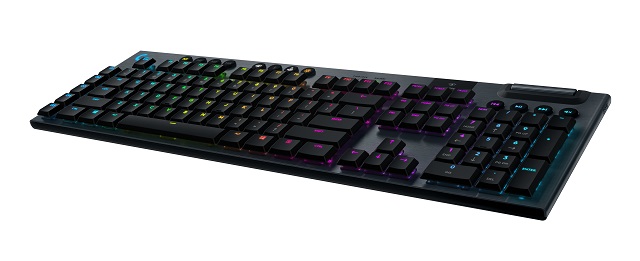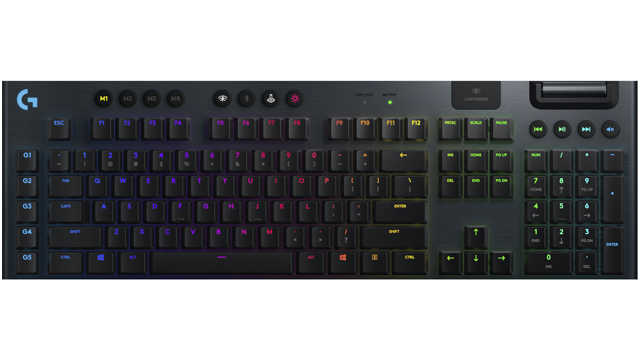I review a lot of keyboards, and with so many releasing each year, even the good ones tend to run together. Every once in a while, though, one really sticks out.
For the past two months or so, I’ve been using Logitech’s new G915. For me, it’s tantamount to a mid-cycle reinvention of the mechanical gaming keyboard. It works expertly for office work and gaming alike. Though, the clicks on some of its switches may be a tad bothersome to certain users.
At $249.99, it puts itself above many other boards in price, but some of the bells it provides will make some whistle straight to the bank. I find it hard that too many will spend so much on a new board in a market flush full of them, but I can see a subset of users flocking to the G915.
After spending dozens of hours with the board, I dare say this is Logitech’s new standard-bearer. It’s well-rounded for almost any use case, whether that be typing up news articles or blasting the competition away in Modern Warfare.

G915 Design
The first thing you’ll notice about the G915 is how surprisingly thin it is. Measuring in at 18.7in x 5.9in x 0.9in, this board is about as thick as a membrane board or something made by Apple. It’s certainly the thinnest board I’ve ever used. While some others, such as the HyperX Alloy Origins, also feature low-profile chassis, the G915 has that plus extremely low-profile keys, making the board incredibly lean.
Something else I like about this board is that the charcoal chassis is durable. Like Logitech’s G513, such a robust design makes carting this board around a breeze; I don’t have to worry about it being resilient or not, and I don’t have to worry about accidentally dinging it against a door frame.
Along the top of the chassis, you’ll find three memory buttons, allowing you to quickly switch between three on-board, editable profiles. Next to those, you’ll find an MR button, which allows you to quickly record macros.
Further right are the Wireless and Bluetooth buttons, the Game Mode button, and the brightness toggle button. At the far-right edge of the board, you’ll find the media buttons for skipping backward, play/pause, skipping forward, and mute. Above those is a corrugated easy-scroll volume wheel that glides effortlessly when rolled.
On the far left side of the board are five “G” keys. All are easy to reach, though I did find myself hitting the bottom-most G-key, “G5,” quite a bit when I instead wanted to hit “CTRL.” On the far right is a full Numpad that comes in handy for office work.
Along the top edge of the board, you’ll find the on/off switch on the left side and a micro-USB charging port toward the right. A variation of this board, the G815, features a USB passthrough along the back as well, though the unit I reviewed, the G915, does not.
Flip the board over and you’ll find the customary two feet on either side. Interestingly — and something I’ve not seen anywhere else — the feet feature two tiers. You can either flip out the larger foot or the smaller foot inside it, giving you multiple height options for various surfaces and/or preferences.
G915 Features
A lot of what we’ve come to expect from gaming keyboards is present here, such as RGB lighting, dedicated gaming keys, and on-board profiles. The RGB here is as vibrant as its ever been on a Logitech board; the game keys are placed elegantly and don’t cramp the board too much; and the three on-board profiles are probably more than most casual users will need.
The features that really shine through are arguably more esoteric than completely necessary. Being able to effortlessly switch between wireless and Bluetooth modes isn’t a new feature to Logitech boards, but it’s an appreciated one. I prefer the placement of the wireless and Bluetooth buttons to the placement of the same buttons on the G613 wireless, for instance.
Lightsync RGB is fun, letting you connect all of your Logitech devices via the company’s G Hub software. If you like one color pattern and effect, and you want it across your mouse, keyboard, and speakers, Lightsync is the ticket.
The board comes with 10 lighting effect presets, six cycle presets, five animation presets, and four animation cycle presets. You can also make your own animations with Freestyle in G Hub. Here, you can choose everything from specific transitions to default speed, and even specific frames within animations. It’s by far the most granular RGB tool I’ve seen in a keyboard, and it’s one that I can see a lot of users having fun with.
As usual, creating profiles and setting macros is a cinch. There’s not much to say here other than Logitech has this down to a science. From specific commands for Discord, OBS, and Overwolf to system strokes, key macros, and other commands, users can set just about anything they’d like. The only disappointing thing here is that you can’t reprogram every key on the board, which is somewhat of an oversight for something of such pedigree.
However “upsetting” that may be, the G915 makes up for it in other areas, such as its ridiculously robust battery life. Logitech boasts 30+ hours of wireless battery life with RGB turned to max. In my time with the G915, I found that to be accurate. Turn RGB off, and you’ll allegedly get 1,200 hours of battery life. Of course, I didn’t use the board for 50 straight days, and I didn’t leave the RGB turned off very much, but the point is that this board shouldn’t unexpectedly die on you.
That’s made more certain by the fact that the G915 also works while plugged in. Yep, you can charge the G915 and use it at the same time. It seems obvious, but many wireless boards don’t provide such functionality, and it’s one that moves the G915 above many of its cohorts in my estimation.

G915 Gaming Performance
While I love the GL Clicky switches in my review unit, I can understand that some won’t love their sharp tone. Luckily, the G915 comes in two other variants — GL Tactile and GL Linear. Though, I can’t speak to those as I did not test them.
Each set might provide different “clicky” styles and tones, but all have identical profiles. Total travel distance is 2.7mm. Actuation distance is 1.5mm. And average actuation force is 50g.
Combine that with extremely linear keycaps, and you have a typing machine that can’t stop, won’t stop. I’ll never be able to go back to my other boards after using the G915. However, we’re not here to talk about office work. So how does it perform in-game?
In a word: wonderfully.
Such low actuation distances mean I can pull off ults and movements in a fraction of the time. Although the actuation force of 50g is a little more than other boards, I didn’t feel like I was pressing any harder than normal. In fact, I preferred it considering lower values might lead to mis-keyed strokes or accidental presses.
I also prefer the low-profile keycaps because I can shift from key to key much faster than I can on other mechanicals. Finger motions feel much more fluid here. Whereas other keycaps are often concave, requiring users to pick their fingers up to move, the G915’s keys are mostly flat, allowing one’s fingers to glide from key to key.
I’m still not sold on the “clicky” nature of the keys while playing games as it can be distracting, but I’m certainly sold on their speed, feel, and accuracy. Other keycaps just feel clunky and brutish by comparison.
—
Pros:
- Razor-thin chassis with low-profile keys
- “G” keys and dedicated media keys
- Easily switch between wireless and Bluetooth
- Three different switch variations
- Fluid, easy-to-find volume wheel
- Insane battery life with and without RGB
- Use while charging
Cons:
- $249 price tag is just a tad high
- No USB passthrough on G915
- No wrist rest
In essence, the G915 has so many options and extras that it’s essentially the only board you’ll ever need. It does so many things right that it’s almost impossible not to recommend to those with deep pockets. I can only groan about this flagship not having a USB passthrough and a wristrest, both of which really ought to come with the board at such a price point, since you can exclusively use this board in wired mode.
Those caveats, though, pale in comparison to the $249.99 price tag. Some of these features are already on the $149.99 G613, even if you get the awesome combo of Lightspeed and Lightsync here. Being able to use the board while charging is a nice plus, and the linear, low-profile keys are enough to drool over. But are they drooly enough to get over the price tag? Maybe, maybe not.
I’ve told several of my friends about this board over the past few weeks, and they’ve been wholly invested until I told them the price point. If more people could try the board before buying, they might have a different opinion, but I fear a cool $249 is just too scary for many.
[Note: A G915 review unit was provided by Logitech for the purposes of this review.]










Published: Oct 30, 2019 05:47 pm